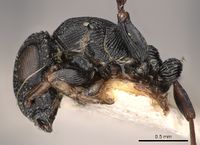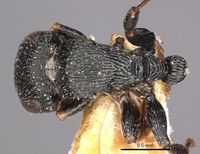Cataulacus adpressus
| Cataulacus adpressus | |
|---|---|

| |
| Scientific classification | |
| Kingdom: | Animalia |
| Phylum: | Arthropoda |
| Class: | Insecta |
| Order: | Hymenoptera |
| Family: | Formicidae |
| Subfamily: | Myrmicinae |
| Tribe: | Crematogastrini |
| Genus: | Cataulacus |
| Species: | C. adpressus |
| Binomial name | |
| Cataulacus adpressus Bolton, 1974 | |
Besides the type being collected from "pyrethrum knockdown", little is known about the biology of what we presume is an arboreal nesting species.
Identification
A member of the tenuis group. The combined characters of size, sculpturation, and the remarkable adpressed hairs immediately identify this species and serve to separate it from the other species related to Cataulacus brevisetosus.
Keys including this Species
Distribution
Latitudinal Distribution Pattern
Latitudinal Range: 6.312222222° to 6.206666667°.
| North Temperate |
North Subtropical |
Tropical | South Subtropical |
South Temperate |
- Source: AntMaps
Distribution based on Regional Taxon Lists
Afrotropical Region: Ghana (type locality).
Distribution based on AntMaps
Distribution based on AntWeb specimens
Check data from AntWeb
Countries Occupied
| Number of countries occupied by this species based on AntWiki Regional Taxon Lists. In general, fewer countries occupied indicates a narrower range, while more countries indicates a more widespread species. |

|
Estimated Abundance
| Relative abundance based on number of AntMaps records per species (this species within the purple bar). Fewer records (to the left) indicates a less abundant/encountered species while more records (to the right) indicates more abundant/encountered species. |

|
Biology
|
Castes
Only known from the worker caste.
Nomenclature
The following information is derived from Barry Bolton's Online Catalogue of the Ants of the World.
- adpressus. Cataulacus adpressus Bolton, 1974a: 30, figs. 15, 18 (w.) GHANA.
- Type-material: holotype worker.
- Type-locality: Ghana: Eastern Region, Bunso, 8.vii.1969, pyrethrum knockdown B.6/4 (D. Leston).
- Type-depository: BMNH.
- Status as species: Bolton, 1982: 355 (in key); Bolton, 1995b: 137.
- Distribution: Ghana.
Unless otherwise noted the text for the remainder of this section is reported from the publication that includes the original description.
Description
Worker
Holotype. TL 3.5, HL 0.90, HW 0.82, CI 91, EL 0.44, OI 54, OOD 0.58, SL ca 0.42, SI ca 50, PW 0.69, AL 0.90, MTL 0.44.
Occipital crest absent; occipital corners each armed with a single low, blunt denticle. Sides of head behind eyes uneven but not denticulate, convergent close to the occipital corners. Preocular tooth small, separated from the eye by a small gap. Pronotum marginate laterally, the humeral angles acute; margination with a number of extremely minute denticles and terminating posteriorly in a single larger denticle close to the promesonotal junction. Mesonotum and propodeum not marginate, without denticles; propodeal spines short and bluntly rounded apically. Promesonotal suture represented upon the dorsum by a very weak impression which does not break the sculpturation and is best visible at the sides where it joins a small, shallow notch separating the pro- and mesonota. Metanotal groove absent. Sides of pronotum in dorsal view more or less parallel, only very slightly convergent posteriorly; those of the mesonotum shallowly convex and convergent posteriorly, separated from the propodeum by a shallow, very broadly V-shaped impression. Propodeal sides with a bluntly convex swelling anteriorly, converging behind to the bases of the spines. First gastral tergite not marginate laterally.
Dorsum of head finely reticulate-rugose, the interspaces finely and densely reticulate-punctate. Dorsum of alitrunk finely regularly longitudinally sulcate with a few transverse sulci between the propodeal spines. Sides of alitrunk obliquely sulcate, those on the propodeum almost vertical. Femora longitudinally sulcate. Anterior surface of petiole and posterior surfaces of both petiole and postpetiole transversely sulcate, but the anterior and dorsal faces of the latter longitudinally so. First gastral tergite with fine, dense longitudinal rugulae throughout its length.
Hairs on all dorsal surfaces of the body from the clypeus to the apex of the first gastral tergite strongly adpressed, sparse, most easily visible upon the clypeus, propodum, postpetiole and gaster. Normal standing hairs present only upon the mandibles, margins of the frontal carinae and extreme gastral apex. A few strongly ad pressed hairs present upon the dorsal surfaces of the femora.
Type Material
Holotype worker, GHANA: Bunso (eastern region), 8.vii.1969, by pyrethrum knockdown (D. Leston) (The Natural History Museum).
References
References based on Global Ant Biodiversity Informatics
- Bolton B. 1974. A revision of the Palaeotropical arboreal ant genus Cataulacus F. Smith (Hymenoptera: Formicidae). Bulletin of the British Museum (Natural History). Entomology 30: 1-105.
- Bolton B. 1982. Afrotropical species of the myrmicine ant genera Cardiocondyla, Leptothorax, Melissotarsus, Messor and Cataulacus (Formicidae). Bulletin of the British Museum (Natural History). Entomology 45: 307-370.



